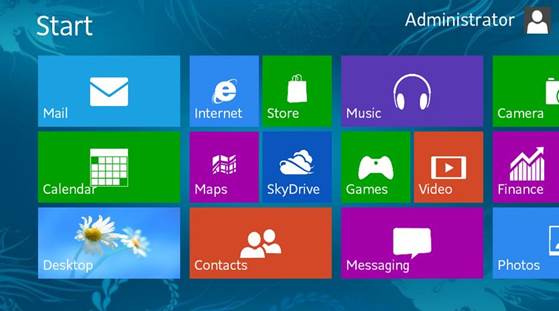Windows 8
Although Windows 7 claimed some level of
tablet support, it was never designed to support the kind of low-power,
low-capability devices this segment of the market favored - to say nothing of
the decidedly mouse-friendly interface. By comparison, Windows 8's interface
was redesigned almost from the ground up to be used with a touch-screen, while
the operating system itself was made available in a version specifically
designed to run on low-power ARM chips: Windows RT. It's fair to say that
Microsoft was making a definite play for the tablet market.
Several months after release, it's clear
that things haven't caught on the way Microsoft hoped they would. Windows 8 has
flopped in the desktop market, and tablet versions - whether the full- fat
Windows 8 or the diet Windows RT version - are feeling the effects of its
negative reception. While Android and iOS are both battling for market share in
the 40-50% range, Windows (including Windows 7 and Windows Phone 7 and 8) is
scraping by on less than 7%, less than half of which is represented by Windows
8-powered tablets.

Windows
8 has flopped in the desktop market, and tablet versions - whether the full-
fat Windows 8 or the diet Windows RT version - are feeling the effects of its
negative reception.
Still, Windows 8 isn't a complete
non-starter. In terms of providing a familiar environment to PC owners, it's
instantly superior to both Android and iOS-based tablets. Windows 8 tablets are
generally quite powerful and act much like a normal PC right down to running
the same software - a definite bonus if you've got software suites you want to
carry around with you. The corporate market in particular enjoys these
features.
It's a good job too, because the main
problem for users interested in a Windows 8 tablet is that they're expensive,
largely because of the internal hardware required to house and run the
operating system to the standards you'd expect of a desktop machine. Even the
cheapest Windows 8 tablets are more expensive than the iPad. Not much of an
incentive to buy one.
In stark contrast, Windows RT is design to
run on the kind of ARM processors routinely found in smartphones and tablets.
It looks and acts much like Windows 8, but dig a little deeper and you'll find
a vastly different piece of software. Rather than running typical Windows
software, it runs Windows Store apps. Some see this as negating the main
benefit of a Windows-based tablet at all, but on the plus side it's much
cheaper to buy a Windows RT tablet and will retain the Windows familiarity some
users want.

In
stark contrast, Windows RT is design to run on the kind of ARM processors
routinely found in smartphones and tablets.
The big problem selling any non-Android or
non-iOS tablet in the current market is that the big two have been around so
long that their software libraries are virtually untouchable. It doesn't help
that the Windows Store looks practically empty compared to its Google and Apple
siblings. In May, there were just 80,000 applications available and many large
brands are missing entirely. There's no BBC iPlayer app specifically designed
for Windows tablets, for example, even though both Android and iOS enjoy one.
There's no doubt that Microsoft is having a
difficult time adjusting to the rapid pace of the tablet market after a slow
start, and it'll be a while before we see whether it can build the tiny flame
it's set alight into a roaring fire or whether it'll get snuffed out. Either
way, it's a fight it can't possibly avoid and consumers should probably do
their best not to get in the way of it until the dust has settled.
The Alternatives
Although 95% of tablets are powered by iOS,
Android or Windows 8, that still leaves 5% unaccounted for. So what are they
running on?
1. HPIPalm WebOS 3.0
WebOS was launched in 2009 by Palm, which
used it to power Its mobile devices. It was later acquired by HP, which used it
to run the Touchpad tablet. A catastrophic reception for the device ensured
that WebOS had no chance of denting Android or iOS' s leads, but the software
has since been sold to LG and is still being actively developed with an eye to
powering the company's smart TVs.
2. BlackBerry Tablet OS / BlackBerry 10
Released in March 2013, BlackBerry 10 is
the operating system charged with reviving BlackBerry's fortunes after years of
the brand's declining performance due to increase competition. Available on
smartphones now, the QNX-based operating system is expected to reach
BlackBerry's tablets {which currently run the separate BlackBerry Tablet OS)
later this year. Despite this, there's currently little reason to think it'll
make any significant Impact on the market beyond its current showing.

BlackBerry
Tablet OS
3. Microsoft Windows 7
Windows 7 is a fully touch-enabled
operating system and one that has attracted much more goodwill than its
successor, Windows 8. As with Windows 8, the low power of tablets means that
the most affordable devices are poorly suited to running Windows 7, which
limited the operating system's prominence in the field, and the release of
Windows 8 means there'll be no more Windows 7 tablets. Despite this, it's still
prominent enough to represent as much as 1-2% of the total tablet market,
according to some estimates.